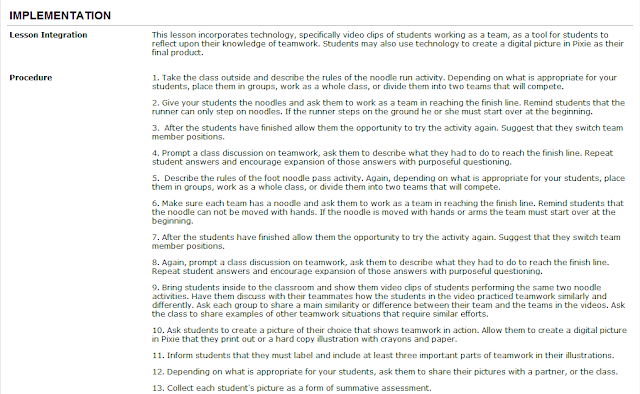Assessing Prior
Knowledge:
If
I were teaching this lesson with a class of third grade students, I would have
previously observed and informally assessed their prior knowledge during
various group activities.
From
these initial group activities I would expect to gather information regarding
each student’s ability to work cooperatively.
This
information would be useful in the planning process so that I could make
adaptations to the lesson based on my students’ prior knowledge. Depending on
my class, I could plan to provide more or less support in defining the concept
of teamwork.
Instruction Plans:
The objective and expected outcome of the lesson are clearly stated in my lesson plan. The objective is developmentally appropriate for the intended third grade learners. The expected outcome is discussed in the procedures of the lesson plan and in the rubric attached. This lesson is based on an Arizona Academic Physical Education Standard for third to fifth grade students.
Designing Instruction:
The lesson plan I created is contextually and logically organized. This lesson plan is part of a larger unit on developing value in physical activity. The lesson process is as follows: we practice physical teamwork activities, we discuss what worked and what didn’t, we watch others practice the same activities, compare and contrast our methods and others, review what we've learned, relate concepts to other teamwork experiences, and finally create and share pictures of teamwork in action. I will meet the needs of individual students by implementing differentiated instruction. If a student is physically unable to take part in the teamwork activities, I will provide an alternative opportunity for that student to participate. For example, I could instruct them to act as a coordinator for their team and give verbal instructions. Students will practice using higher order thinking skills in creating their own teamwork situations. The technology integration for this lesson includes watching video clips of students performing teamwork activities and possibly using the Pixie program to create a digital picture. As research recommends, students are presented with an opportunity to use technology in an interactive manner.
My
lesson plan does not specifically address safe, legal, and ethical use of
digital information and technology. Nor does it specifically address digital
etiquette and responsible social interactions. However, prior to this lesson
students will be informed of proper Internet use and expected to practice it
continuously. As it is necessary, I will remind and review with students how to
properly use the Internet. This instructional design is built to meet the
diverse needs of students in the way that suggested accommodations for
differentiated instruction are included. The strategies are learner-centered in
the way that prior knowledge is considered and each student creates their own
unique depiction of teamwork. Equitable access is supported in the way that
every student in the class will watch video clips from YouTube and have the
opportunity to use a computer to create a digital drawing. This lesson plan
does not address digital-age communication and global awareness.
Planning Assessment:
I will assess each student's final product, a labeled teamwork picture. This assessment will demonstrate the performance of each student in relation to the objective: The student will actively participate in two group physical activities and then create a labeled picture in Pixie or by hand, that expresses at least three elements of teamwork in a setting or situation of their choice. I created a detailed rubric (found below) to help effectively and consistently assess each individual student. Again, higher order thinking is supported in the way that students are assessed on their own original creative drawing.







No comments:
Post a Comment